Blog updated 18.11.2025
Do you have “See the Northern Lights” on your bucket list? If so you are going to want to add a winter trip to Iceland to your future plans so you can make this dream come true! This beautiful natural occurrence is only visible in certain parts of the World and here in Iceland, we are lucky enough to be one of the best places to see them. The only thing for you to figure out is when to book your trip to maximize your chances of seeing the dancing lights. To help you make that decision, keep on reading to learn the best time of year to see the Northern Lights in Iceland, ways to see the Northern Lights, and helpful apps and tools to assist on your search. We have all the answers to your questions to help you maximize your chances of spotting them!
Looking for a winter and Northern Lights tour in Iceland?
The Ultimate Northern Light Guide
In this article:
- What are the Northern Lights
- 11-year solar cycle
- Everything you need to know about the Northern Lights in 2025
- Solar storms
- What is the best month to see the Northern Lights?
- What is the best time of day to see the Northern Lights?
- Ways to see the Northern Lights in Iceland
- The best place to see the Northern Lights in Iceland
- Helpful apps & tools to hunt the Northern Lights
- The best Northern Lights tours in Iceland
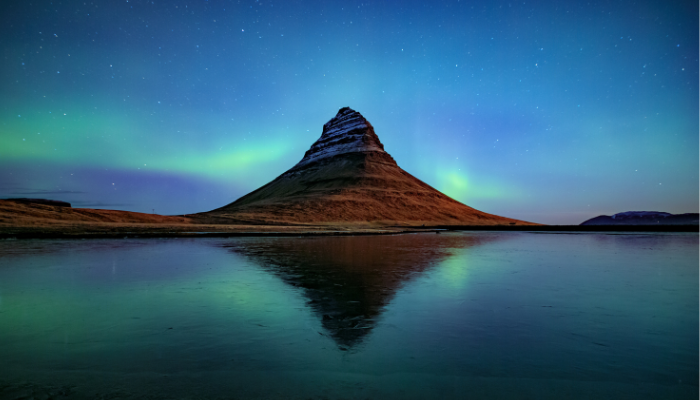
Northern lights dancing over Kirkjufell Mountain
What are the Northern Lights?
First off let’s do a quick science lesson on what exactly causes the Northern Lights. The Northern Lights occur because of an interaction between the solar wind, which is the stream of charged particles emanating from the sun, and the Earth's magnetic field. The lights we see in the night sky are actually caused by activity on the surface of the sun. Solar storms give out huge clouds of electrically charged particles. These particles then travel to Earth's hemisphere and appear in a clear sky as swirling rivers of greenish-blue light. This occurs around the Polar Regions where magnetic fields cover. Meaning, not everywhere is lucky enough to see the Northern Lights, in fact, they typically can only be seen between 60-75 degrees of latitude which covers northern parts of Canada, Norway, Sweden, Finland, Alaska, Russia, and ALL of Iceland.
There is nothing more magical than being bundled up and watching the mystical streaks of color dance their way across the dark winter sky!
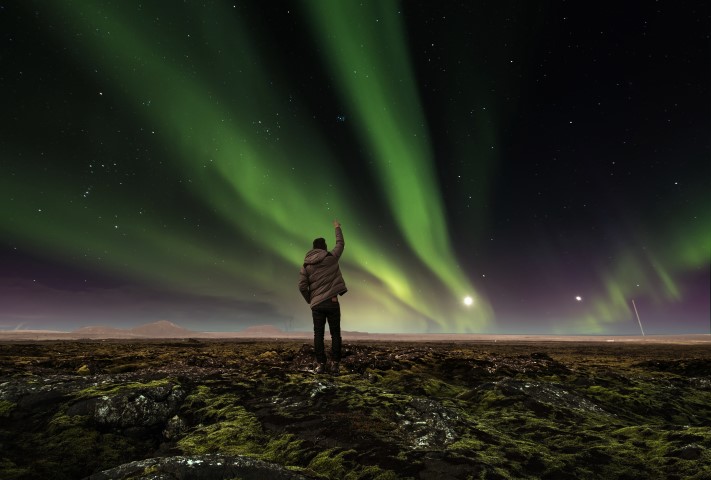
Imagine standing under the green-lit sky, marveling at the display of lights.
The Best Years for Northern Lights Are Here
Understanding the Solar Cycle
The Northern Lights are influenced by the sun’s activity, which follows an 11-year solar cycle. When the sun is most active, known as the solar maximum, auroras become brighter, more frequent, and more vivid. The last peak occurred in 2013, and now we’ve reached the next one: 2025 marks the solar maximum.
This surge in solar activity means 2025 is one of the best years in over a decade to see the aurora. Expect dramatic skies filled with vibrant greens and, during strong solar storms, rare hues like purple and red.
What Happens After the Peak?
The magic doesn’t end when the solar maximum passes. In fact, the years immediately following often bring steady and spectacular auroras, sometimes even more consistent than during the peak itself. Forecasts suggest this heightened activity could last until 2029, giving travelers a generous window to experience the Northern Lights at their best.
Why This Period Is Special
- 2025: Peak solar activity: frequent, intense auroras.
- 2026–2029: Post-maximum years with stable, vivid displays.
- Rare colors: Solar storms can add purple, pink, and red to the usual green glow.
If you’ve been waiting for the perfect time, the next five years are your golden era.
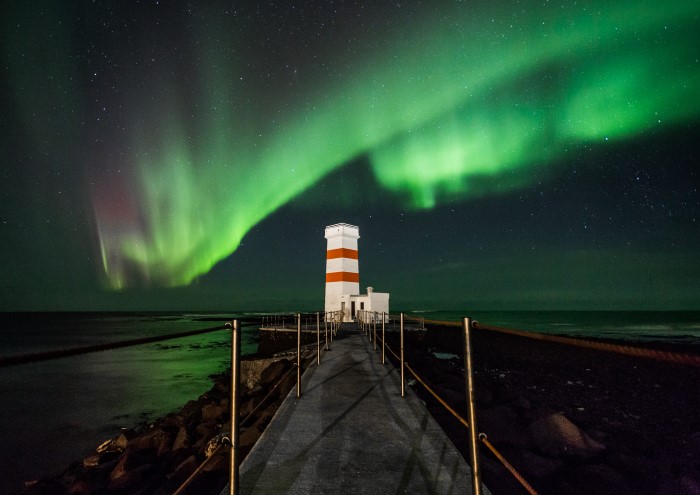
A lighthouse under wonderful streaks of green and purple
Solar storms
In addition to these more or less regular variations in the frequency of the aurora, there are also less predictable, erratic displays resulting from solar storms. Some of these, particularly near solar-activity maximum, can lead to visible Northern Lights remarkably far south if you're in an area with clear, transparent night skies. In places that typically can see the Northern Lights, such as Iceland, a solar storm causes the lights to be very intense with vivid colors dancing across the sky. If you are lucky enough to witness the Northern Lights during a solar storm you will be in for quite the show and likely will get to see additional colors such as purple and red mixed in with the greenish-yellow lights.
What is the best month to see the Northern lights?
Choosing the best month is like choosing our favorite waterfall in Iceland, it is impossible to give just one answer! However, we will provide some information on the Northern Light season so you can make the decision on the best month for your trip to Iceland.
First off, the most important step needed for the Northern Lights to be visible is darkness. This may seem like a given, and not provide you with much insight because everywhere has nighttime, and nighttime equals darkness. Except in Iceland where that actually isn’t always the case. During the months of mid-April to late August, the nighttime skies actually stay quite bright thanks to the Midnight Sun, which means that even if the Northern Lights are out and active they would not be visible in the bright nighttime skies.
With all that in mind, we can now narrow down the months to late August to mid-April for the official Northern Light season. Now let’s break it down even further to help maximize your chances of seeing the Northern Lights.
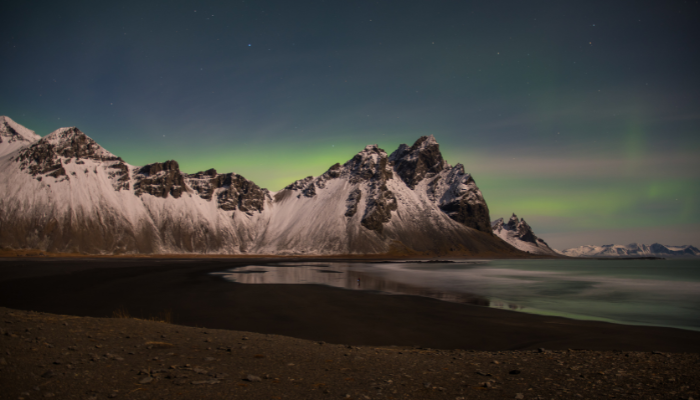
From late September to late March the sun sets by 6 pm meaning you can get an earlier start on your Northern Light search. An annual trend we see in Iceland is that the Northern Lights are at their peak in September and March which we can thank the equinox in these months for. Looking at the other months in the Northern Light season, November through February are the darkest months in Iceland with just a few hours of daylight per day meaning they offer the longest evenings which can increase your chance of seeing the Northern Lights. However, one caveat we will add, during these months we can get some winter storms which cause heavy cloud coverage. Since clear skies are needed to see the Northern Lights a dark evening with heavy cloud coverage would not be ideal.
As you can see, there is really no one best answer to this question, it is all about taking into account the pros and cons of each month and making the best decision for your travel plans. Being a naturally occurring phenomenon, the appearance of the Northern Lights is notoriously difficult to predict any further in advance than about two hours before it happens. So much is dependent on solar activity and, whilst we can estimate the number of sunspots that might occur on the sun, we can’t accurately predict either when they will occur or how frequently.
No matter what month you chose to visit Iceland, joining a Northern Light tour can help maximize your chances of viewing the Aurora as the guides are trained to watch the forecast closely and find the best viewing spots for that particular evening.
What is the best time of day to see the Northern Lights?
Now that you understand the science behind the Northern Lights you are well aware that first and foremost, to see the Northern Lights, the skies must be dark. This immediately rules out daylight hours and, contrary to popular opinion, it is not pitch black in Iceland for the entire winter. Despite the sun not appearing above the horizon, even on the shortest day, 21 December, Iceland still gets three to four hours of beautiful gray/blue light which renders the Northern Lights invisible to the naked eye.
Once darkness falls, the Aurora can be visible at any time of day, but even with a dark sky, it seems the Northern Lights like to wait to come out until between 9.30 pm to 1 am with a peak in activity happening between 11pm-1am when the sky is the darkest.
Bonus tip! Not so much a night owl but don’t want to miss your chance at seeing the Northern Lights? A lot of hotels offer a complimentary Northern Light “wake up service” so you can get some rest and they will call you to let you know if the lights are out dancing in the sky.
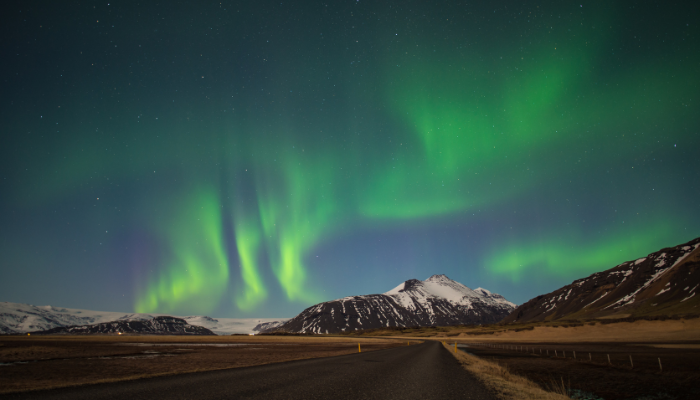
Clear, crisp sky away from light pollution
Ways to see the Northern Lights in Iceland
People tend to picture seeing the Northern Lights as they step outside the door of their accommodation. Or maybe you imagine it happens while out for an evening stroll in Reykjavik. You may have even been told you can only see the Northern Lights by taking a bus tour to a lava field outside of the city. While these are all actually ways you can see the Northern Lights in Iceland there is actually an even broader variety of options!
You can spot the Northern Lights…
…by walking
If the conditions above are in your favour, the Northern Lights may appear in the sky above you. And you may not have to walk very far to enjoy a magnificent display of colourful lights! Put on your warmest jacket, hat and mittens and go for a walk. Enjoy the silence of the crisp Icelandic winter night and be amazed by the Aurora. Depending on where you are walking you may need to head away from bright city lights. But as always, practice safety first and be aware of your surroundings, you don’t want to miss a moment of the Northern Light’s magic by getting lost.
…by car
If you are doing a self-drive tour and have a rental car, you can drive in almost any direction in the search for the perfect spot. You just never know when you will be out driving and the Northern Lights will appear so keep a look out as you enjoy your road trip. Just remember to drive carefully in the dark and snowy winter nights, and be sure to pull off in a designated parking area well away from the side of the road.
…on a guided tour
If you like organized tours and want to be in the safe hands of a local guide, you can book a scheduled Northern Lights tour through a number of tour operators. The guides are skilled in ‘hunting’ for the Northern Lights and knowing the best locations to spot them based on each night’s Aurora and weather forecast. Northern Lights tours are scheduled almost daily during winter. You can take a bus tour, super jeep experience, a boat ride, float in geothermal pools or even view them from the top of a glacier. You are bound to find at least one tour that appeals to you. There are many advantages to booking a scheduled Northern Lights tour. Guided tours have the advantage of being led by experts who closely follow the forecasts and have knowledge about road conditions and terrain. Another benefit is you won’t have to worry about driving yourself in the dark and snowy winter night. Of course, those tours will also take you to landscapes and location you may otherwise not experience. An added bonus of one of these tours, if you do not have any luck on seeing the Northern Light’s most tours will include taking you out for the coming nights until you do get your magical Northern Light sighting.
… on a boat
This might not be an option you have thought of before, but what a memorable experience it would be! A Northern Lights hunt at sea is an amazing experience and you will find a few operators offering these amazing tours. Great scenery and absolutely unique experience.
…in the countryside
Stay at an Icelandic countryside accommodation for a few days to maximize your chances of seeing the Northern Lights away from the city lights. Enjoy the warm atmosphere of an Icelandic farm, get to know the locals, explore nearby natural attractions by day and hunt for the Northern Lights by night.
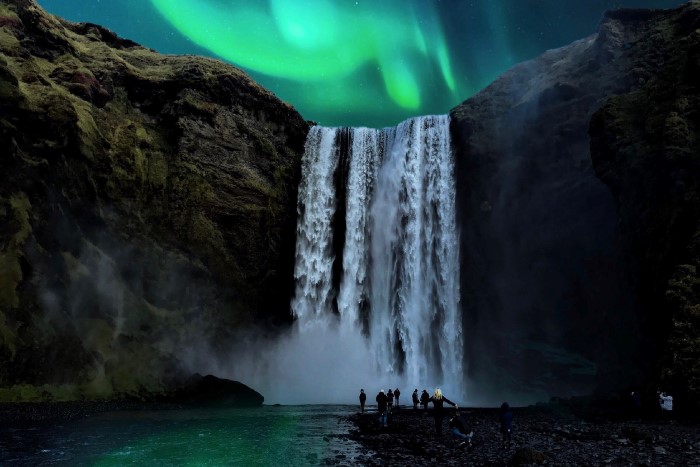
Auroras dancing over Skógafoss Waterfall
Where is the Best Place to See the Northern Lights in Iceland
- Can you see the Northern Lights from Reykjavík?
- Can you see the Northern Lights from the Blue Lagoon?
Northern Lights trips are organized around the country all winter long. There are for example numerous tour operators offering these late-night sightseeing excursions from Reykjavík, of which we recommend the Northern Lights Mystery Tour and Northern Lights Cruise. The ideal location for sightings varies and the local guides are skilled in ‘hunting’ the lights, finding locations where conditions are best for seeing them each night.
In most cases, chances of catching the Northern Lights are immediately improved outside populated areas, away from city lights. That being said, the Aurora can often be seen dancing over the capital and other towns. Most hotels around the country offer a special Northern Lights wake-up service, so if lights happen to appear, they will let you know. A longer stay in one location will also improve your chances of spotting this magical natural phenomenon.
Helpful apps & tools to hunt the Northern Lights
Now that you have all the tips to keep yourself safe, let's add a few more into the mix to help increase your chances of seeing the Northern Lights in Iceland.
- Before you head outside, check the Aurora forecast online here to see which area will have the best chance of spotting the Northern Lights - pay attention to the cloud cover!
- Request a wake-up call at your accommodation. Many accommodations offer a Northern Lights wake-up call so be sure to request one before you go to sleep so you won’t have to worry about missing the show.
- Join this Facebook group where locals post when the Northern Lights are active in their area. It is a great way to get a heads up by the locals who are always on the watch for them.
- Download the Hello Aurora app and be able to check the forecast wherever you are.
- Northern lights almost always start from the north direction, so when keeping a lookout for them to appear look north!
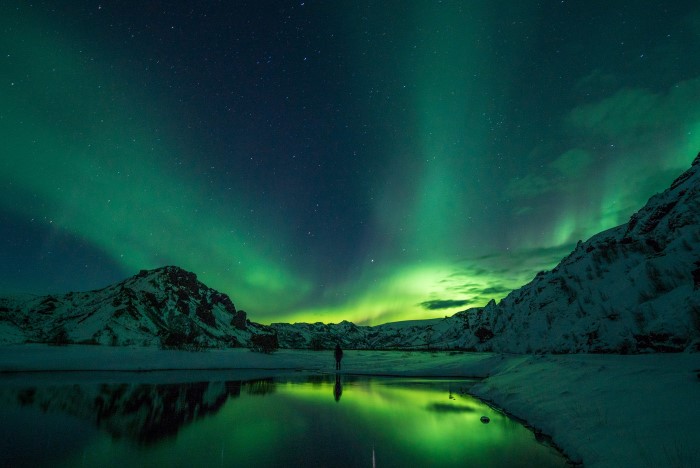
The further you travel from cities and towns, the bigger the chances of spotting the Northern Lights
The best Northern Lights tours in Iceland
Looking for a self-drive itinerary for hunting the Northern Lights in Iceland? Or a fun and unique activity or day tour with an expert guide?
Look no further!
Looking for a winter and Northern Lights tour in Iceland?
View our bestseller Northern Lights 8 day Self-Drive Tour!
Northern Lights day tours and experiences
Interested in learning even more about the fascinating Northern Lights? We recommend you take a look at our article about How, Where, and When to See the Northern Lights in Iceland, and make sure you are prepared for your Northern Light adventure with this post all about how to view the Aurora safely. And if you are convinced already, then book your Northern Lights tour today!